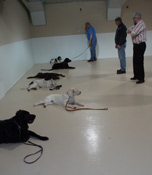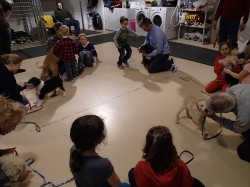Hot weather can make us all uncomfortable, and it poses special risks for your dog. Keep the following safety concerns in mind as the temperature rises, and follow our tips to keep your dog cool.
Heat Hazards
If your dog is outside on a hot day, make sure he has a shady spot to rest in. Doghouses are not good shelter during the summer as they can trap heat. You may want to fill a child’s wading pool with fresh water for your dog to cool off in.
Never leave your dog in a closed vehicle on a hot day. The temperature inside a car can rise to over 100 degrees in a matter of minutes.
Always provide plenty of cool, fresh water.
Avoid strenuous exercise on extremely hot days. Take walks in the early mornings or evenings, when the sun’s heat is less intense.
Try to avoid prolonged exposure to hot asphalt or sand, which can burn your dog’s paws.
Dogs that are brachycephalic (short-faced), such as Bulldogs, Boxers, Japanese Chins, and Pekingese, have an especially hard time in the heat because they do not pant as efficiently as longer-faced dogs. Keep your brachycephalic dog inside with air-conditioning.
General Health
Make sure your dog’s vaccinations are up to date, especially since dogs tend to stay outdoors longer and come into contact with other animals more during the summer months.
Keep dogs off of lawns that have been chemically treated or fertilized for 24 hours (or according to package instructions), and away from potentially toxic plants and flowers.
Keep your dog well-brushed and clean.
Fleas and ticks, and the mosquitos which carry heartworm disease, are more prevalent in warmer months. Ask your veterinarian for an effective preventive to keep these parasites off your dog. The AKC Pet Healthcare Plan can help with the cost of providing quality healthcare, including preventive medicine, throughout your dog’s life.
Beach Tips
Make sure your dog has a shady spot to rest in and plenty of fresh water.
Dogs, especially those with short hair, white fur, and pink skin, can sunburn. Limit your dog’s exposure during the day and apply sunblock to his ears and nose 30 minutes before going outside.
Check with a lifeguard for daily water conditions. Dogs are easy targets for sea lice and jellyfish.
Running on the sand is strenuous exercise. A dog that is out of shape can easily pull a tendon or ligament, so keep a check on your dog’s activity.
Do not let your dog drink seawater; the salt will make him sick.
Salt and other minerals in ocean water can damage your dog’s coat, so rinse him off at the end of the day.
Not all beaches permit dogs; check local ordinances before heading out.
Water Safety
Most dogs enjoy swimming, but some cannot swim, and others may hate the water. Be conscious of your dog’s preferences and skills before trying to make him swim.
If you’re swimming for the first time with your dog, start in shallow water and coax him in by calling his name. Encourage him with toys or treats. Or, let him follow another experienced dog he is friendly with.
Never throw your dog into the water.
If your dog begins to paddle with his front legs, lift his hind legs and help him float. He should quickly catch on and keep his back end up.
Don’t let your dog overdo it; swimming is very hard work and he may tire quickly.
If swimming at the ocean, be careful of strong tides.
If you have your own pool, make sure your dog knows where the stairs or ladder are located. Be sure that pool covers are firmly in place; dogs have been known to slip in under openings in the covers and drown.
Never leave your dog unattended in water.
Travel
By Air – Many airlines will not ship animals during summer months due to dangers caused by hot weather. Some will only allow dogs to fly in the early morning or in the evening. Check with your airlines for specific rules.
If you do ship a dog, put icepacks or an ice blanket in the dog’s crate. (Two-liter soft drink bottles filled with water and frozen work well.) Provide a container of fresh water, as well as a container of frozen water that will thaw over the course of the trip.
By Car – Keep your dog cool in the car by putting icepacks in his crate. Make sure the crate is well ventilated.
Put a sunshade on your car windows.
Bring along fresh water and a bowl, and a tarp or tent so you can set up a shady spot when you stop. Keep a spray bottle filled with water to spritz on your dog to cool him down.
By RV – A dog’s safety should not depend on the air conditioning and generator systems in an RV or motor home. These devices can malfunction, with tragic results.
If you leave your dog in an RV with the generator running, check it often or have a neighbor monitor it. Some manufacturers have devices that will notify you if the generator should malfunction.
Never leave an RV or motor home completely shut up, even if the generator and AC are running. Crack a window or door or run the exhaust fan.
Never, ever leave a dog unattended in a vehicle in the summer months. Heatstroke and death can occur within minutes in warm temperatures.
Heatstroke
Heatstroke can be the serious and often fatal result of a dog’s prolonged exposure to excessive heat. Below are the signs of heatstroke and the actions you should take if your dog is overcome.
Early Stages:
- Heavy panting.
- Rapid breathing.
- Excessive drooling.
- Bright red gums and tongue.
- Standing 4-square, posting or spreading out in an attempt to maintain balance.
Advanced Stages:
- White or blue gums.
- Lethargy, unwillingness to move.
- Uncontrollable urination or defecation.
- Labored, noisy breathing.
- Shock.
If your dog begins to exhibit signs of heatstroke, you should immediately try to cool the dog down:
- Apply rubbing alcohol to the dog’s paw pads.
- Apply ice packs to the groin area.
- Hose down with water.
- Allow the dog to lick ice chips or drink a small amount of water.
- Offer Pedialyte to restore electrolytes.
Check your dog’s temperature regularly during this process. Once the dog’s temperature has stabilized at between 100 to 102 degrees, you can stop the cool-down process.
If you cannot get the dog cooled down and you begin to see signs of advanced heatstroke, take the dog to the veterinarian immediately.

